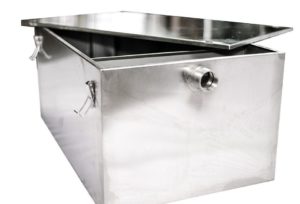
From fatbergs weighing 130 tonnes to recurrent flooding caused by blockages, Britain’s sewers are under siege. If we continue to flush fat, oil and grease (FOG) and non-biodegradable items into the sewers, the situation will only get worse.
Water UK estimates there are more than 300,000 FOG-related sewer blockages in Britain each year, costing the taxpayer around £100 million to clear. Blockages lead to sewer flooding, which can cause untreated sewage to run into homes, gardens, and in the worst-case scenario, contaminate the water supply.
While the correct disposal of FOGs has long been recognised as a problem by wastewater companies, the public remained largely oblivious to their role in clogging up the sewers. However, viral stories such as the infamous Whitechapel fatberg—a piece of which remains on the display at the Museum of London—have captured the public’s imagination and lead to the issue receiving wider media attention.

A Commercial Issue
Wastewater from commercial kitchens contains a higher concentration and volume of FOG than domestic kitchens. But fatbergs are not created by FOGs alone. They are formed by FOGs combining with domestic household waste such as wet wipes to form giant calcified masses. Despite this, it is the foodservice industry which the water companies hold more accountable for sewage blockages.
Recently in Nottingham, a restaurant was prosecuted and ordered to pay a total fine of £8,419 for flooding in the local area, caused in part by FOG discharge. A representative from Severn Trent Water told reporters that this case was “totally avoidable” and that “simply installing a suitable grease trap and making sure it’s maintained could have prevented the situation”.
Every foodservice outlet in the country has a legal obligation to manage its “effluent content” under the Water Industry Act 1991. With more exposure in the media, foodservice outlets are being put under increasing pressure to manage their waste effectively as highlighted in the WRAP Envirowise Guide. Yet it is estimated that only 30% of Britain’s 400,000 commercial kitchens have some sort of FOG mitigation system in place.
Britain’s largely Victorian sewer network will not be able to cope with increasing urbanisation, higher concentrations of food outlets, and climate change if the current rate of blockages remains.
It is highly unlikely that it will ever be economically or practically viable for the government to insist on the installation of domestic grease traps. Therefore, rightly or wrongly commercial businesses will continue to bear the financial brunt of tackling the issue.
The Simple Solution...Install a Grease Trap
In an ideal world, Britain’s sewage problem would be solved if all commercial kitchens installed a grease trap. Grease traps stop FOGs at source and are the most cost-effective measure to ensure that commercial kitchens are adhering to legislation.
The issue is that approximately half of the 30% of commercial kitchens with a FOG mitigation 
In that regard, a campaign run by Scottish Water in Fife could set an industry standard. They worked with environmental inspectors from Environmental Compliance and Services (ECAS) to visit 172 foodservice businesses to educate them on how to effectively install grease traps. As a result, 119 new or larger grease traps were installed, preventing 140 tonnes of FOG entering the sewage system each year.
While there is evidently a long way to go, the very fact that the industry is beginning to engage in a discussion about the best ways to manage FOG is a positive step towards change in commercial kitchens.

Leave a Comment
Your email address will not be published. Required fields are marked *